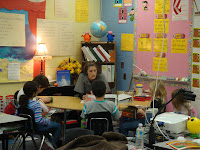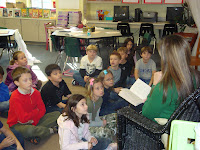 ers to stretch further than they've ever been in the area of technology. Our instructional technology coach, Melanie, has them using tools like google docs, google maps, wikis, blogs, and google reader. She's also been supporting them as they pilot a new on-line grade book. This level of change creates disequilibrium and it has been interesting to watch how different teachers have handled this added level of risk.
ers to stretch further than they've ever been in the area of technology. Our instructional technology coach, Melanie, has them using tools like google docs, google maps, wikis, blogs, and google reader. She's also been supporting them as they pilot a new on-line grade book. This level of change creates disequilibrium and it has been interesting to watch how different teachers have handled this added level of risk.Chets Creek Elementary is a K-5 professional learning community with 1,300 learners in Jacksonville, FL. Coaching Chronicles was first created when I served as the school's Instructional Coach (2004-2011). I have since served as a third grade learning leader(2011-2013), and am now the school's Assistant Principal. Regardless of my role, this blog shares snippets of our learning journey and Creek Life.
Thursday, January 22, 2009
We Need Change
 ers to stretch further than they've ever been in the area of technology. Our instructional technology coach, Melanie, has them using tools like google docs, google maps, wikis, blogs, and google reader. She's also been supporting them as they pilot a new on-line grade book. This level of change creates disequilibrium and it has been interesting to watch how different teachers have handled this added level of risk.
ers to stretch further than they've ever been in the area of technology. Our instructional technology coach, Melanie, has them using tools like google docs, google maps, wikis, blogs, and google reader. She's also been supporting them as they pilot a new on-line grade book. This level of change creates disequilibrium and it has been interesting to watch how different teachers have handled this added level of risk.Wednesday, January 21, 2009
Standards-Based Bulletin Boards Focus Walks
 data to make decisions on short-term needs and long-term goals. This information is analyzed and decisions are made for whole group and small group pd topics, much like a teacher would do to prescribe instruction in their own classroom.
data to make decisions on short-term needs and long-term goals. This information is analyzed and decisions are made for whole group and small group pd topics, much like a teacher would do to prescribe instruction in their own classroom.
3. Conversations among vertical teams about the standards, tasks, and student work gives teachers the opportunity to see beyond their grade level. They see the span of work produced from Kindergarten through Grade 5 and are able to see the global picture of student performance. The walk also allows teachers to see if we have total alignment K-5 among our subject areas. If there is a gap, it is discussed, analyzed, and solutions brought to the forefront.
Standards-based Bulletin Boards collapse the four walls of the classroom, take student work out of the portfolio crate, and make student performance visible. From a coaching position, days like this are purposeful and powerful, and one I would highly recommend for any school.
If you are in a school were Standards-Based Bulletin Boards are the culture, here are some quick and easy steps to make a day like this happen in your own building:
Wednesday, January 14, 2009
Grade 2 Focus Walk
 Early in December, our Grade 2 ELA team spent a day together planning for an upcoming non-fiction reading and writing unit. They analyzed the standards, wrote lessons, and discussed expectations. Today, I strolled through Grade 2 on an informal focus walk to see the non-fiction work that is unfolding.
Early in December, our Grade 2 ELA team spent a day together planning for an upcoming non-fiction reading and writing unit. They analyzed the standards, wrote lessons, and discussed expectations. Today, I strolled through Grade 2 on an informal focus walk to see the non-fiction work that is unfolding. onducting a Guided Reading group using a non-fiction text while the rest of the students were independently reading in their reading nooks. Strolling through the third classroom, I saw students meeting during the mini-lesson as th
onducting a Guided Reading group using a non-fiction text while the rest of the students were independently reading in their reading nooks. Strolling through the third classroom, I saw students meeting during the mini-lesson as th e teacher modeled for them how to use their schema to approach a topic. She then modeled how to use a graphic organizer to record your schema, then read a text on your topic, and finally fill in your new learning. At a later point in my walk, I observed students in one classroom taking a non-fiction reading assessment. All in all, a clear picture emerged that this unit has gotten off to a good start.
e teacher modeled for them how to use their schema to approach a topic. She then modeled how to use a graphic organizer to record your schema, then read a text on your topic, and finally fill in your new learning. At a later point in my walk, I observed students in one classroom taking a non-fiction reading assessment. All in all, a clear picture emerged that this unit has gotten off to a good start. Looking Toward the Future
This year, that ideal has changed due to budget cuts and now we are carrying two coaches. One full time instructional coach (me) and an instructional technology coach. We opted for the technology coach so we could begin digitally warehousing and sharing information on-line, and promote self-learning opportunities. This cut has us relying more heavily on lead teachers who run PD in their content area at their grade level. With that said, they also have full-time teaching responsibilities. Therefore, without coaches with release time, we have gone from substantial in class coaching to virtually none. What implications this will hold are forthcoming.
So, to prepare, I have four ideas:
#1 Capture, edit, and upload as many videos as possible from classrooms and warehouse them on our Setting the Standard ning.
#3 Form PLC’s based on needs and passions rather than by grade levels.

#4 Lead our teachers to be self-directed learners, avid readers, collaborative workers, and community contributors.
Saturday, January 10, 2009
Bullying Stops Here
 This week, our behavior interventionist and a dedicated member of our Foundations team kicked off our first anti-bullying campaign. They began with a PowerPoint of quotes that our Media Specialist has heard from students this year like, "He hurts me everyday in the hallway when no one is looking.” “I don’t tell on him because he told me he would choke me, just like last year.” Then, continued with data collected in a survey of teachers, parents, and intermediate students.
This week, our behavior interventionist and a dedicated member of our Foundations team kicked off our first anti-bullying campaign. They began with a PowerPoint of quotes that our Media Specialist has heard from students this year like, "He hurts me everyday in the hallway when no one is looking.” “I don’t tell on him because he told me he would choke me, just like last year.” Then, continued with data collected in a survey of teachers, parents, and intermediate students.Simply put, I was shocked. You see, Chets is an educational utopia, a close knit learning community where we all feel safe and supported...or so I thought. The data collected, may look outstanding to an outsider, especially if they work in rougher schools, but led to the alarming fact that although the greatest majority of our students feel safe within our classrooms, more unstructured areas like the hallways, cafeteria, restrooms, playground, and bus stops are an area of concern. And, many students, at one point or another, have been the target of bullies, have bullied themselves, or hav
 e been a witness of bullying. Students in the survey say...
e been a witness of bullying. Students in the survey say... •52% of fourth graders agree.
•20% of fifth graders agree.
I was picked on or teased in a mean way by students.
•26% of third graders agree.
•48% of fourth graders agree.
•29% of fifth graders agree.
•57% of fourth graders agree.
•29% of fifth graders agree.
So, in an effort to turn these percentages into 0%, the Foundations team has put in place a week of anti-bullying activities and among other things will be educating students through closed circuit T.V. Below is one video that will most likely be shared with our students.
If you have other helpful anti-bullying literature or campaigns going on in your school, please post a comment so I can share it with our team to ensure that all CCE students feel safe, unbullied, and appreciated. After all, even one student being bullied is too many. In my mind, I think, what if it was my own son?
Sunday, January 4, 2009
7 Things You Don't Need to Know About Me


